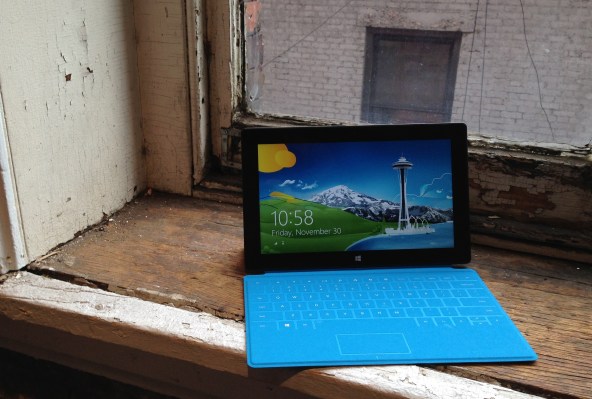The Surface Pro launches in January, just after the holiday rush. It’s a pricey bauble at $899 plus an extra hundred for the Touch Cover. But everyone is excited. This is the model most of the Surface sympathizers are waiting for. It has the full Windows 8 experience, a capable Intel chipset, and an ecosystem two decades in the making. But here’s the problem: come January the Surface Pro could have serious competition from Asus, Samsung, Lenovo and maybe even HP. In short, what happens when the big guys finally catch up to Microsoft?
As of this writing, pickings for a Windows 8 tablet are pretty slim. To the rabid Microsoft fan, the Surface Pro looks like the second coming. It’s the tablet that will save them from the horrid iPad. But fear not, friend. The Surface Pro will be just one among many options soon.
The Surface Pro still has all the UX awkwardness of the Surface RT. As Sarah Perez aptly stated, the Surface is a tablet that’s actually a desktop computer. The addition of the Intel chipset will not improve the floppy connection between the Surface and the Touch Covers. It will still be awkward to use anywhere but on a flat surface.
CES kicks off in early January and every vendor will likely have Windows 8 tablets of all shapes and size. And the big boys will all be aiming for arrogant Microsoft and its darling Surface. And don’t forget Microsoft isn’t at CES this year.
Expect Samsung to roll out countless Windows 8 devices of all shapes and sizes. Samsung after all is riding high on the success of its mobile division. If anyone can take on Microsoft (and Apple) it’s Samsung. The Korean giant introduced several launch models at IFA in late Summer, but they have been slow to get to market. Likewise, the models introduced at CES will probably hit stores in the second quarter of 2013.
Asus should have a good CES showing. This is the company that practically pioneered the docking tablet. The Transformer Android tablet line is Asus’s recent claim to fame after the fall of the netbook. The Asus VivoTab looks like a fine compromise between portable a form factor and capable hardware. But hopefully Asus will debut a higher-end model that’s powered by something other than an Atom chip. Plus, since it’s from Asus, the prices should be rather competitive although, with that, comes piss-poor customer support.
Lenovo is gearing up for a big year as it is expected to surpass HP as the largest PC vendor in the world. The company has always found success with innovative, forward-thinking products. Look at the ThinkPad Tablet 2: Much of the magic of the Surface Pro including pen-based input and keyboard but for only $649.
Ironically, given the company’s past dominance, HP is the wildcard in the Windows 8 tablet game. HP is still the leader in PCs and has a massive manufacturing and distribution supply chain. The company could go all-in on a tablet, win CES and regain its spot as a leader in PCs. But that’s not likely. CEO Meg Whitman’s five-year HP restructuring plan doesn’t call for new products until financial year 2014.
It’s an exciting time for the Windows world but the Surface RT and Pro are poor standard bearers for the cause. It’s simply not a good flagship model as the shortcomings greatly outnumber the advantages. Thankfully, come CES, more options will surface.
